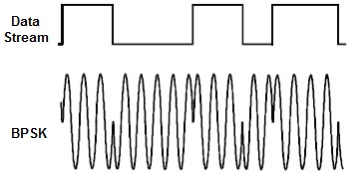To study BPSK Modulation & to observe the spectrum of BPSK Signal..
The AM and FM modulation schemes can be used to transmit digital signals and this allows for the channel to be shared. As digital data forms the message instead of speech and music, it is preferred that these two systems are called ASK and FSK instead. Recalls that ASK uses the digital data's ls and Os to switch a carrier between two amplitudes. FSK uses the ls and Os to switch a carrier between two frequencies. An alternative to these two methods is to use the data stream's ls and Os to switch the carrier between two phases. This is called Binary Phase Shift Keying ( BPSK ) . Fig.1 below shows what a BPSK signal looks like time - coincident with the digital signal that has been used to generate it.
 |
Notice that, when the change in logic level causes the BPSK signal's phase to change, it does so by 180°. For example, where the signal is travelling towards a positive peak the change in logic level causes it to reverse direction and head back toward the negative peak and vice versa.
You may find it difficult to see at first but look closely and you'll notice that alternating halves of the BPSK signal's envelopes have the same shape as the message. This indicates that BPSK is actually double-sideband suppressed carrier (DSBSC) modulation. That being the case, BPSK generation and the recovery of the data can be handled by conventional DSBSC modulation and demodulation techniques.







